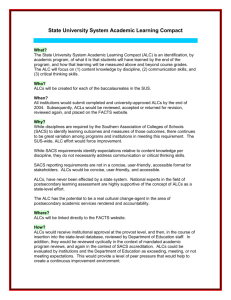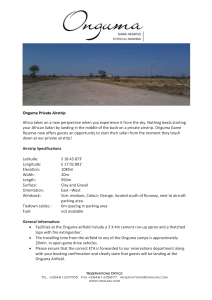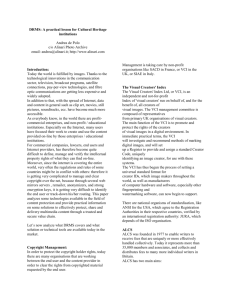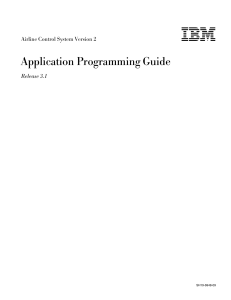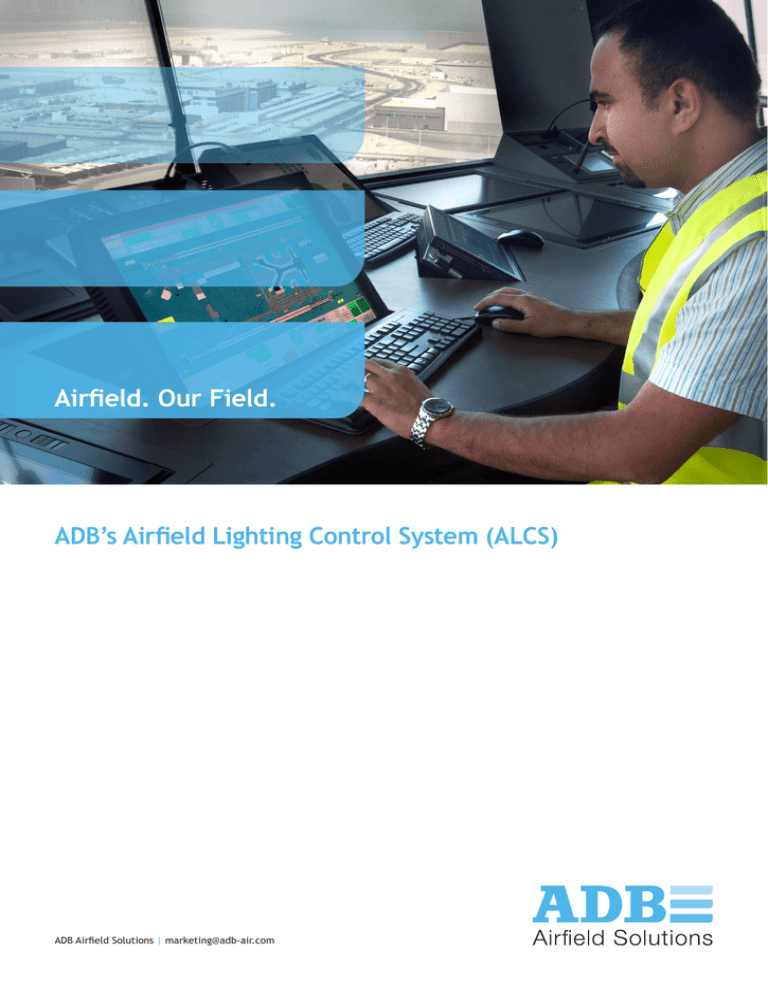
Airfield. Our Field.
ADB’s Airfield Lighting Control System (ALCS)
ADB Airfield Solutions | marketing@adb-air.com
ADB’s Airfield Lighting Control System (ALCS)
Reference to standards
ICAO:
FAA:
IEC:
Annex 14, Volume I, (Aerodromes) current edition, Aerodrome Design Manual, Part 5
ICAO Manual of Surface Movement Guidance and Control System, DOC 9476-AN/927,
AN/452 first edition 2004
AC 150/5345-56 (current edition): Specification for L-890 Airport Lighting Control and
Monitoring System (ALCMS) Advisory Circular (AC)
62143 - 61508
Today’s airports are dealing with ever increasing air traffic. And while ensuring safety remains
paramount, there are other mounting pressures such as reducing operations costs and carbon
footprint.
ADB’s Airfield Lighting Control System (ALCS), that enables control and monitoring of Airfield Ground
Lighting (AGL) equipment installed on the airfield, helps airports manage high traffic volumes
steadily and safely. The system has a wide range of functionalities for operations staff including Air
Traffic Controllers (ATCs) and maintenance staff, helping them:
■■ Achieve higher throughput while maintaining utmost safety standards
■■ Increase safety of ground traffic operations through unambiguous visual guidance
■■ Benefit from easy visual guidance via preselected taxiing routes
■■ Achieve simple and adequate stop bar control ensuring safety and preventing runway incursion
■■ Get easy access to all Airfield Ground Lighting (AGL) information at first glance
■■ Get permanent status update of visual aids, and monitor its compliance in line with operational
conditions
■■ Get transparent and detailed status information on all workstations to proactively conduct
preventive maintenance
■■ Integrate with other airport systems such as
• Runway Incursion Alerting functionality (SCIPS),
• Runway Status Lights (RWSL) and
• Advance Surface Movement Guidance and Control (A-SMGCS)
■■ Monitor Gen Sets, High- and Low Voltage Switchgear and their auxiliary equipment required to
ensure visual guidance
■■ Reduce carbon footprint (applicable for high-end A-SMGCS system solution)
ADB provides modular designed ALCS, based on reliable and high-speed industrial control equipment,
customized to individual airport requirements and in line with ICAO’s Aerodrome Design standards.
ALCS panel
ALCS screen
Functionalities and Applications
ALCS functionalities and operational applications
■■ Selection of Airfield Ground Lighting (AGL) functions, providing status and intensity control per
AGL function of lights from PAPI to touch down zone, threshold, runway to taxiways and apron
according to the visual range and landing direction:
• Activation of general lighting settings using an ICAO compliant preset table as per visibility
mode (day, twilight, night), runway visual range and category of operations (CAT)
• Selection and switching of groups of lights via intuitive Human Machine Interface (HMI)
touchscreen
• Dedicated taxiway and stop bar control commands
■■ Operational applications
• Semi automatic ATC support functions:
-- Visual guidance along taxiways and stopbar
control with automated stop bar activation
via timer or, preferably, partial surveillance
by local ADB field sensors (AFS) or other
surveillance means
-- Route assignment of ground traffic and
individual visual guidance to define, adapt,
select and activate the preferred taxiing routes
• Automated airfield lighting with interface to
surveillance systems:
-- A-SMGCS with conflict prediction, recognition and avoidance
** Dynamic routing and individual visual guidance with intersection control for automated
taxiing procedures, increased safety and throughput
-- Runway Incursion Alerting functionality (SCIPS Sensor Controlled Incursion Protection System)
-- Runway Status Lights (RWSL) control system
■■ View of actual operational, maintenance and alarm status of the ALCS system and the airfield
ground lighting equipment
ADB’s typical, user-friendly tools for AGL control,
preventive maintenance and fault analysis
All ALCS operations can be implemented at each
Human Machine Inteface (HMI) at all system levels
with password protection, from ground traffic
management to the electrical component level
Status display of group of lights via push button
image – on / off / maintenance / error
Easy- to-use HMIs and common touch screen
HMI functionalities at all ALCS locations – tower,
maintenance/technical room, substations
Maintenance operation and status visualization with individual CCR control and (optional) true
feedback indication of lamp status
Detailed list of actual alarms for troubleshooting with sorting, filtering, printing mode,
selectable Air Traffic Control (ATC) or maintenance level via user access code. World renowned
visualization system and Supervisory Control and Data Acquisition (SCADA) for data logging,
processing and visualization
Modular and scalable system platform
Customized ALCS as per specific application requirements
ADB has been a frontrunner in control solutions for AGL ever since the introduction of PC- and PLCbased control systems. Our ALCS is based on a modular and scalable system platform that grows with
airport requirements. The ADB ALCS product family for regional and international hub airports ranges
from simple to most complex systems with server-based architecture, enabling selection and specific
adaptation of AGL control features for all sizes and levels of complexity:
■■ An out-of-the-box system for one runway and up to 24 airfield lighting circuits:
ALCS Style 1
is the state-of-the-art system for simple and straightforward control and monitoring. For more
information, please refer to the Style 1 leaflet (order number A09.201e)
■■ Basic system:
ALCS Style 2 and 3
tailored to the needs of airports with one substation (Style 2) or two substations (Style 3) with
typical 32 Constant Current Regulators (CCRs) per substation.
For more information, please refer to the Style 2-3 leaflet (order number A09.203e)
■■ For airports with an AGL system with Individual Lamp Control and Monitoring System (ILCMS) and
typical 32 CCRs per substation:
ALCS Style 4
Redundant PLC S7 300.Connection between PLC and CCRs either dual JBus or redundant
multiwire.
■■ For integration to other airport systems and typical 64 CCRs per substation:
ALCS Style 5
Redundant server-based ALCS with fibre optic ring connection between substations and to other
airport systems such as A-SMGCS. Industrial PLC of well known brand in substations with dual JBus
or redundant multiwire interface to CCRs.
■■ For basic routing and guidance with interface to other airport systems; typical 64 CCRs per
substation:
ALCS Style 6
Redundant server-based ALCS with fibre optic ring connection between substations and other
airport systems such as A-SMGCS. Industrial PLC of well known brand in substations with dual JBus
or redundant multiwire interface to CCRs.
■■ For enhanced system availability, redundancy and maintenance functionalities and ALCS as key
component in an integrated A-SMGCS Level 3 and 4 system solution:
ALCS Style 7
Server-based ALCS with redundant fibre optic ring connection between substations. Separate
maintenance node/nodes and extended maintenance and SCADA features. A-SMGCS key
component for dynamic routing with route- and sequence proposals and individual visual
guidance. High-available PLC S7 400H with JBus interface to typical 128 CCRs per substation.
The ALCS system family is scalable and based on modular software & hardware design, allowing for
integration with other airport systems – with the goal of sharing operational information.
ADB ALCS Styles 4-7 are for airports with high traffic throughput and enhanced safety requirements
with active ground traffic control through visual guidance; control of taxiway center line lights,
holding positions and stopbars.
Topology and Interfaces
ALCS System Topology
Human Machine Interfaces (HMI) receive user inputs and
show status of the AGL equipment.
For ALCS Style 5 and higher, data volume requires servers.
Up to four server(s) are used for merging data from
several PLCs and user interfaces, tracking and recording
of events and alarm database.
User
Workstations
(2-4)
Server (5-7)
PLC
PLCs process the control logic and act as interface
between the AGL equipments and server(s).
Controllable AGL equipment: Constant Current Regulators
and Airport Auxillaries.
CCR
AUX
More complex airfield lighting systems require a serverbased concept with interfaces to other airport systems to manage the volume of AGL data and
variable parameters, allowing storage, clustering and visualization of status and alarm messages.
Main components of the ALCS modular system family for medium and large airports
Highest availability through a redundancy concept
ALCS is based on many years of experience in AGL products and systems development, with a special
focus on safety, including relevant fail-safe modes of operation as an option. This ensures that even
if the main ATC workstation fails, control and monitoring of CCRs do not suffer.
Communication Tower-Substation
For ALCS Style 5 and higher, we offer two redundant fiber optic cables with multi-mode upto 3.500m
between Tower and Substation to interface between all components, HMIs, server, PLC and AGLAS
Masters. The network is based on an ETHERNET standard (IEEE 802.3) using TCP/IP protocols.
Option: Alternative communication via fiber optic cable, single mode (up to 15.000m).
Communication and AGLAS
Communication to other airport systems
AWOS = Airport Weather Operation System
RVR = Reduced Visual Range
SMGCS = Surface Movement and Guidance System
GOS = Gate Operation System
ILCMS = Individual Light Control and Monitoring
System
Maintenance
HMI’s
ATC
HMI’s
Power
AWOS &
RVR
SMGCS
ALCS
CCR’s
Besides the above listed systems, ALCS can also
ILCMS
be connected to the “airport clock” and NTP,
ensuring synchronous time stamping of event logs
ALCS Interfaces
and communication synchronization, where
applicable. Control and monitoring interfaces to
CCRs is typically done either with J-Bus, a subset of Modbus, or Profibus.
Sensors
GOS
Logic
control
Communication within Substation
Control and monitoring interfaces to CCRs is typically done either with J-Bus, a subset of Modbus, or
Profibus. Control and monitoring of auxiliaries are done with multiwire. The local PLC has sufficient
digital inputs and outputs.
Option: Unshielded Twisted Pair (UTP) or preferred: CAT5 / CAT 6 cable with TCP/IP communication
and all CCRs being connected via a local network.
ALCS with Individual Lamp Control
AGLAS®
From Style 4 on, ALCS is complemented by AGLAS®,
ADB’s individual lamp control and monitoring
system. AGLAS® acts as a subsystem to ALCS
and enables switching and monitoring of each
individual light and lighting segments of AGL
serial circuits such as stopbars and taxiway center
line lights. The ATC selects a taxiing route and
defines the released taxiway segment, and AGLAS®
ALCS mask with dedicated status information of individual
lights with AGLAS®
Block diagram of an AGL circuit without / with individual lamp control
by AGLAS®
ALCS high end integration
activates the dedicated AGL fixtures to provide visual guidance.
AGLAS® is also applied as a preferred solution if only monitoring of lamp status in the protected
runway safety zone is required, for instance the status of runway center line and edge lights.
Whether it is halogen or LED fixtures, inset or elevated lights, various AGL fixtures can be
individually controlled and monitored by AGLAS®.
Modular system architecture with an interface to CCRs of your choice
ALCS Style 4. Alternative options of Multiwire (left) or J-Bus (right) interface
between substation PLC system and CCRs
High-End Systems. Server-based ALCS with airport integration – Styles 5-7
ALCS Styles 5 to 7 are a high-end server-based system with
interfaces to other airport management equipment. The
technology system includes visualization and operation, PLC
S7-300 up to 400H dual J-bus for control and communication,
and AGLAS® individual lamp control. It enables the ATC to
operate the entire lighting system via easy-to-use touch
screen monitors. Operational features, system status and fault
messages are clearly visible in well-structured masks on the
controller HMI in the tower and maintenance HMIs in each
substation. While the controller work station is focused on the
operational status of airfield ground lights, the maintenance
station monitors the actual status and error messages of the
electrical components, CCRs and system interfaces.
ALCS control room
ALCS Style 7 server, PLC and interface panels in
the substation with maintenance PC
System architecture of Style 7. A redundant fiber optic ring connects
the Tower to the Maintenance Node and Substations. In the substation,
PLCs and their interfaces to upto 128 CCRs via a high-available dual
J-Bus are also redundant.
Surface Movement Guidance and Control
ALCS as part of A-SMGCS – Style 7
The high-end ALCS Style 7 is a state-of-the-art system for easy and straightforward control and
monitoring of visual aids, customized to the needs of complex airports with multiple runways and
their airfield lighting circuits for the entire AGL system of the airport.
ALCS and ADB’s Airfield Ground Lighting Automation System AGLAS® are key components in an
integrated system solution for dynamic routing and individual visual guidance as per the ICAO and
Eurocontrol specification of Advanced Surface Movement Guidance and Control Systems A-SMGCS.
ICAO and Eurocontrol specify routing and guidance in different A-SMGCS levels
An integrated system solution, A-SMGCS with ALCS Style 7 provides immense cost efficiencies,
amongst a host of operational and safety benefits:
■■ Financial savings
Since the system is scalable and offers a modular design and architecture, airports can reuse a lot of
their existing equipment and enjoy savings from fewer system extensions.
■■ Energy savings
Since the system dynamically switches on only those lights required for the dedicated visual
guidance process; with all other lights are off, airports enjoy huge energy savings.
■■ Maintenance savings
The system has a transparent, easy to understand and select as per priority status and error
messages. It also offers statistical analysis of factors such as operational hours, electrical power
consumption etc. to plan preventive maintenance. Last but not the least is the use of industrial,
commercial-of-the-shelf hardware components that add up to savings in maintenance.
■■ Safety benefits
Conflict prediction and prevention and unambiguous, intension based visual guidance for all aircraft
on the entire airport enables a wide range of safety benefits. While the controller expresses
his intension to guide the pilot along a route, he only needs to mouse-click on some positions /
crossings; post which the automated system connects all points to a consistent route.
■■ Operational benefits
As a result of reliable, better predictable taxiing schedules (how long an aircraft needs from
touchdown to parking position), steady ground traffic flow (less stop-and-go), more throughput
(number of take offs and landings) especially under low visibility conditions, airports enjoy many
operational advantages.
■■ Reduced workload of Air Traffic Controllers
The system provides a range of automated support functionalities in route selection and visual
guidance to the pilot, reducing the overall workload of ATCs.
Examples of operational applications
Stop Bar Control
Ground traffic at runway entrances and critical intersections is safely managed by dynamically
operated stop bar lights.
B
B
A
A
concept of stopbar operation
ADB’s system solution for Runway Incursion Alerting
Sensor Controlled Incursion Prevention System (SCIPS)
A smart and easy to realize feature for ground traffic, monitoring all active holding positions an
the entire airside and raining an unambiguous individual visual alert in case of unintended position
overrun.
Especially suited to enhance stopbar operation and drastically reduce the risk of dangerous traffic
conditions after runway intrusions.
concept of SCIPS
Runway Status Lights (RWSL)
Red inset lights positioned parallel to
runway centerline line lights at take off
position (Take Off Hold Lights) and on
taxiway at runway entrances (Runway
Entrance Lights) warn pilots if it is
dangerous to take off or enter the runway.
Runway Status Light (RWSL) concept integrated to ALCS from ADB
Examples of operational applications
Routing and visual guidance
Air Traffic Controllers select dedicated taxiway centerline segments to visually guide pilots from
touch down to parking position and from push back to take off.
Route selection for visual aircraft guidance with ALCS Style 7
ATC activation and display of dedicated taxiing routes with ALCS Style 7 and
individual aircraft guidance via AGLAS® lamp control
ALCS for maintenance, supervision, analysis and documentation
■■ CAT monitoring, checking, reporting
■■ ALCS as network management with secured remote access, sms and mail services
■■ AGL power monitoring
■■ Operation monitoring for preventive maintenance and spare part management
■■ Maintenance scheduling tool
■■ Configurable threshold for lamp fault and earth fault detection and warning per segment
178 dpi
ALCS maintenance example: monitoring of airfield lighting in CAT condition
Key features and user benefits
ALCS Styles 4-7 offer a range of sustainable customer benefits:
■■ Modularity and commercial-off-the-shelf (COTS) hardware components
• Minimum installation time, easy to maintain
• Modular design for all sizes and complexities of airfields and AGL installations
■■ Adaptability and growth
• The modularity of ALCS enables extensions by adding additional user interfaces in AGL
substations. This facilitates modifications for future airport growth and upgrades
■■ Customized airfield lighting visualization and control
• Full flexibility in creating an image of the airfield layout and visualizing AGL equipment
• PLC for control and monitoring facilities, SCADA package for HMIs, data storage and
visualization, all from the same well known brand
• Automated support functions for the ATCs to reduce workload
• Centralization of technical data (status, alarms, events, etc) of AGL and external equipment to
improve efficiency and effectiveness of maintenance operations
■■ Safety through redundancy and industrial standards
• Redundant, synchronized, industrial-type server PCs
• Proprietary PLC with proven integrity: Siemens Simatic S7 300 to 400H
• Uninterruptable power supply
• Primary communications network can be a redundant fibre-optic “ring” with redundant
network components
• Client-Server architecture guaranteeing continuous visualization and operations
• In case of server fault, each client has the same capabilities and can be used to replace a
defective one
• Industrial standard ETHERNET™ as TCP/IP communication protocol to sub systems
• Control and monitoring of CCRs using an ADB communication protocol. Alternative/option:
multiwire interface
Packing and Storage (example ALCS Style 7 components)
Dimensions Server panels:
Weight Server panels:
Dimensions PLC panels:
Weight PLC panels:
Dimensions AGLAS Master panel:
Weight AGLAS Master panel:
2200x600x600mm
255kg
2100x600x600mm
240kg
2200x600x800mm
225kg without 19” Master chassis
Storage temp:
Storage humidity:
-20°c to 45°C
5% to 95% noncondensing
Recommended Specifications
The Airfield Ground Lighting Control and Monitoring System has to be designed to ensure a safe
and user friendly method of ATC operator interface for airfield lighting in accordance with ICAO
Annex-14, Volume-1, including its latest amendments and the ICAO related manuals and Aerodrome
Design Manual Part-5.
The ALCS should feature one control workstation in the ATC control tower with one large size
touch screen HMI, linked to all substations for typically up to 228 constant current regulators per
substation having a serial Jbus or a multiwire control interface, and dedicated I/O under 48 V DC for
auxiliaries. Number of controlled circuits should be selectable between 16 and 228, depending on
airfield lighting layout by using circuit selectors.
The system should be based on standard PLC of well-known brand for medium complexity of airports
or PLC in combination with redundant servers for complex layouts for AGL control and monitoring
facilities and a COTS SCADA package for the user interfaces of the ATC and maintenance computers.
Each system version should include optional workstations being added to the ATC control tower
and in each maintenance station, with touch screen HMI and printer. Alternatively, an optional
maintenance laptop computer can be used in the substations for maintenance activities.
In order to safeguard long term availability and reliability of the system, the components in the
substation should be of industrial grade.
Depending on the data rate requirements and ALCS system version, the communication medium
should either be a telephone cable with DSL modems allowing a distance up to 3 km, or fibre optic
rings and Optical Media Converter allowing distances up to 15km. Both of these need to use the
international Ethernet standard for TCP/IP communication at 10/100 Mbit/s.
All the control equipment installed in the substations should be mounted in an industrial grade
cabinet. The cabinet’s dimensions and internal layout of equipment should provide an optimum
match for the airport’s requirements, also taking into account future upgrade possibilities.
Control and monitoring equipment should be secured with a UPS. The status of each UPS is to be
monitored on the system’s HMIs. Alarms and warnings are issued to the operators when the system is
running on the UPS or when the batteries get empty.The standard backup duration of the UPS should
be 20 minutes and can be extended with additional battery packs.
ADB Airfield Solutions
Leuvensesteenweg 585
B-1930 Zaventem
Belgium
Phone: +32 (0)2 722 17 11
Fax:
+32 (0)2 722 17 64
marketing@adb-air.com
www.adb-airfieldsolutions.com
© ADB
all rights reserved
order number DOCA09204EV1
subject to modifications
www.comith.be
For more information on the ALCS Style 1-7 system family and ADB’s individual lamp control and
monitoring system AGLAS®, please contact your regional sales desk, visit our website and download
the AGLAS and ALCS system documentation.

